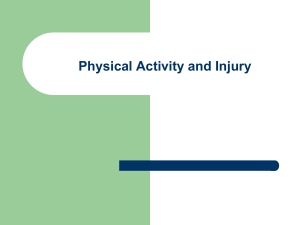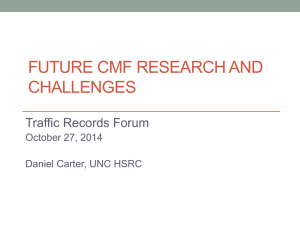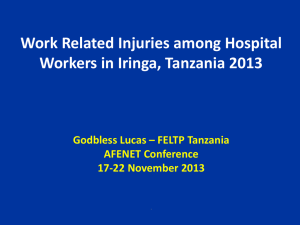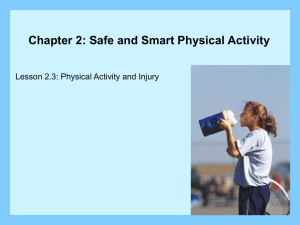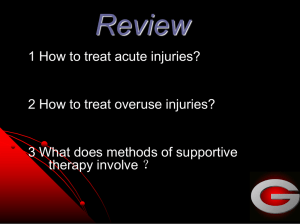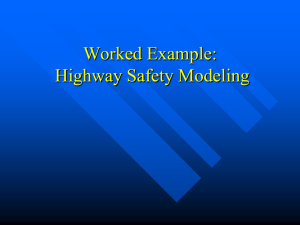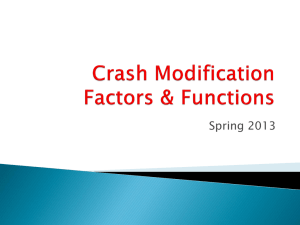Towards zero deaths and serious injuries Implementation of a Safe
advertisement
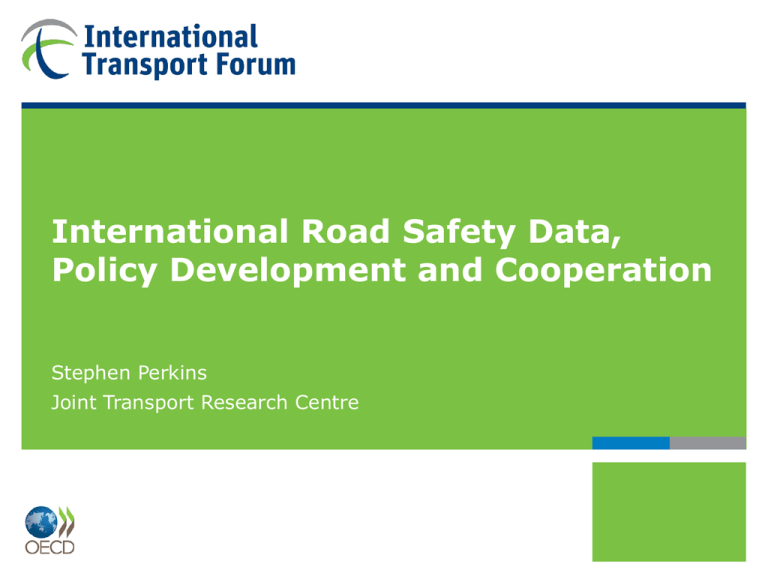
International Road Safety Data, Policy Development and Cooperation Stephen Perkins Joint Transport Research Centre 2 The International Transport Forum at the OECD Annual Think Tank Summit Intergovernmental Organisation 3 Outline • Policy for accelerating reductions in deaths and serious injuries • Targets and the importance of data and analysis • International benchmarking and policy transfer • UN Decade of Action • Improving data on serious injuries • Transfer of evaluation results 4 Road Safety Policy Towards Zero: Ambitious Targets and the Safe System Approach • Sweden and Netherlands have led the way • Vision Zero and Sustainable Safety • Inspiring long term vision to eliminate deaths and serious injuries • Steady progress through interim targets based on funded interventions • Netherlands targets 2020: – Deaths < 500 – Serious injuries < 10 600 5 Reduction in Fatalities: Change 2010/2001 0.0% -30.0% -40.0% -50.0% New Zealand Canada United States Australia Norway Poland Korea Greece Israel Belgium Finland Czech Republic Switzerland Hungary Denmark Italy Austria Japan Netherlands United Kingdom Germany Ireland Portugal Slovenia France [ Cambodia: +300% ] -55% Sweden -60.0% Luxembourg Spain -10.0% -20.0% -18% 25 6 Killed per 100 000 IRTAD countries 2010 20 15 10 5 0 7 20 18 16 14 12 10 8 6 4 2 0 Killed per Billion Vehicle km 2010 Ingredients for success8 reported by countries • Active and passive safety of vehicles – Passenger protection (EuroNCAP) – Electronic Stability Control • Speed management – Automatic speed cameras – Section control • Safer infrastructure – Expansion of Motorway network – Median barriers • Young drivers – Graduated licensing • Legislation – Demerit point systems – Random breath testing – Lower BAC level for young and professional drivers 9 Policy context for success of the past decade 1. Political awareness – E.g.. President Chirac (France) in July 2002 ; Spain 2. Adoption of safe system approach principles – « Towards zero » progressively become the standard – Sweden and NL were pioneers 3. Adoption of road safety targets – ECMT and EC (-50%) targets – National targets 4. Regular monitoring 5. Road safety action plans The UN Decade of Action for Road Safety 2011-2020 11 May 2011 11 UN Decade of Action United Nations Road Safety Collaboration www.who.int/roadsafety/en/index.html www.roadsafetyfund.org DECADE GLOBAL PLAN Five pillars for a Safe Systems approach Managing road safety Safer Roads & Mobility Safer Vehicles Safer User behaviour www.who.int/roadsafety/decade_of_action/ Post-crash response 13 UN Decade of Action • UN Decade of Action Global Plan based on the safe system approach • Five Pillars Objectives: • Maximise fundraising potential of the UN Decade of Action for Road Safety • Promote the Tag to generate funds from corporate and philanthropic sectors and public Private sector engagement: • Global Supporters donate $150,000 per year, minimum 3 years - directed funding, to agreed project - undirected donation • Supporters can join for $15,000 a year Safe road infrastructure assessments in more than 60 countries. Motorcycle safety campaigns and ‘helmets for kids’ in Vietnam and Cambodia 19 Research Collaboration to Benefit Safety of all Road Users IRTAD: International Traffic Safety Data and Analysis Group • Mission – High standard road safety database – Analysis of data with peers – Network for road safety data and analysis professionals • Expert working group – Under the umbrella of ITF and OECD – Funded separately by subscription from members 21 60 Members 33 Countries 22 Knowledge transfer: IRTAD Twinning Projects • Objective to progressively expand geographical coverage, while keeping a high quality database • Twinning : Existing Member + LMIC: – Audit of national crash data system: collection and analysis – Training focused on specific – Regular exchanges of staff over 3 years • Argentina – Spain: – After one year, adoption in almost all Provinces of a common crash data form • Cambodia – Netherlands – Linking Police and Hospital Data – Target seting for 2011-2020 road safety strategy • Funding through voluntary contributions – MOU with the World Bank – FIA Foundation – IADB, Others 23 Ibero American Road Safety Observatory • Following the succesful twinning between Argentina – Spain • Creation of the Ibero American Road Safety Observatory (OISEVI): – Launched by 18 countries in March 2012 • IRTAD LAC database with a Spanish interface • Objective: learning tool and progressive inclusion in IRTAD IRTAD MEMBER COUNTRIES IRTAD-LAC 25 26 The Serious Injury Problem 140 • Why slower progress? 140 Korea 120 120 100 100 80 80 60 60 40 40 INJURED FATALITIES 20 20 0 1995 0 1997 1999 2001 2003 2005 2007 2009 • Can we trust the data? 2010 Fatalities France Germany 3 992 3 648 Hospitalised 30 393 x2 62 620 Injured 84 461 x4 371 170 27 We need better injury record systems • To assess the real number of serious injuries – Real costs of road crashes • To understand the consequences of different crash types • To design adequate countermeasures to reduce serious injures 28 Reporting injuries: IRTAD recommendations • Complement police data with hospital data • Medics not police to assess severity of injuries • Classify injuries to international standards – Maximum Abbreviated Injury Scale (MAIS) • Link police and hospital data – Deterministic and probabilistic methods exist • Agree an international definition of serious injuries for research and benchmarking Define ‘seriously injured road casualty’ as injuries assessed at level 3 or more on the Maximum Abbreviated Injury Scale “MAIS3+” 29 MAIS3+ Example Region Injury description Head and Neck Cerebral contusion 3 Face No injury 0 Chest Flail chest 4 Abdomen Minor contusion of liver 2 Complex rupture of spleen 5 Extremity Fractured femur 3 External No injury 0 MAXIMUM Report: http://www.internationaltransportforum.org/ irtadpublic/pdf/Road-Casualties-Web.pdf Abbreviated Injury Scale 5 30 New Collaborative Road Safety Research • Cycling Safety • Motorcycling Safety • Implementing the Safe System Approach 31 Sharing Road Safety Developing an International Framework for Crash Modification Functions Road safety policy is increasingly dependent on sound indicators of the effectiveness of countermeasures - CMFs are fundamental Prospect of rapid advances and major cost savings through the transfer of results internationally Transferability relies on analysing the extent to which a CMF is dependent on the circumstances in which it was developed Variability in CMF research results is a major deterrent to transferability - can be reduced by making the CMF a function of the relevant circumstances 32 Recommendations Road safety policies should undergo performance and efficiency evaluation - cannot be undertaken without CMFs Follow the guidance in the report and provide information on essential reporting elements Coordination of research on priority countermeasures should be considered within an international group (TRB, PIARC, other) Transnational database is needed for CMFs A concerted effort should be made to publicize benefits of decision-making based on CMFs 33 Conclusions • Safe system principles standard for developing road safety policies. • Implies a long term vision that no one killed or seriously injured. • And interim targets based on modelled impact of measures adopted. • Modelling impacts needs reliable crash modification functions. • Needs good data and analysis, including injury data. • Police and hosptial data are complementary and can be usefully linked. • International definition of serious injury is needed MAIS 3+ should be considered. • International benchmarking and knowledge transfer important – enhanced opportunities in Decade of Action. Thank you stephen.perkins@oecd.org www.internationaltransportforum.org



